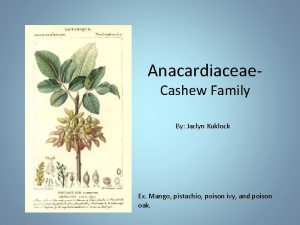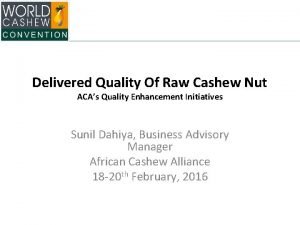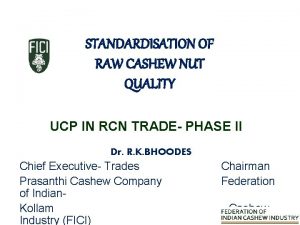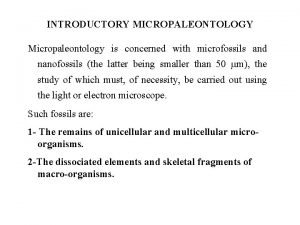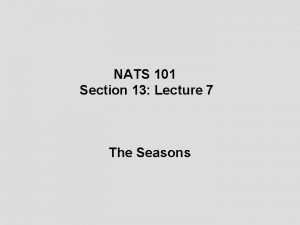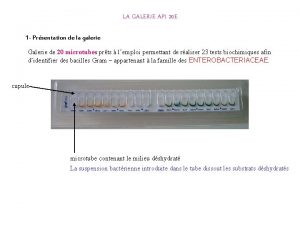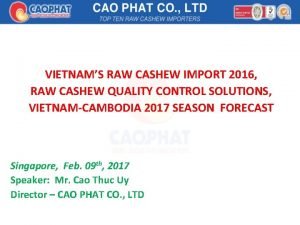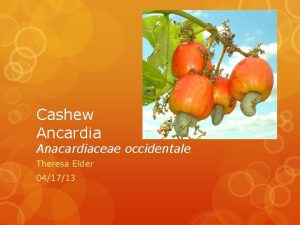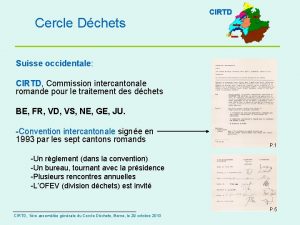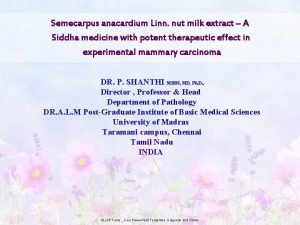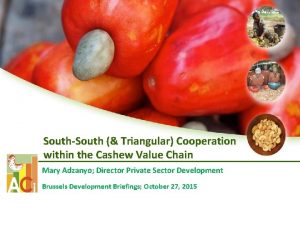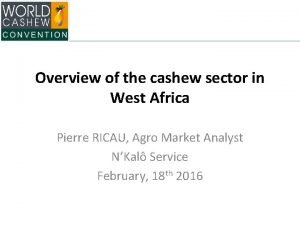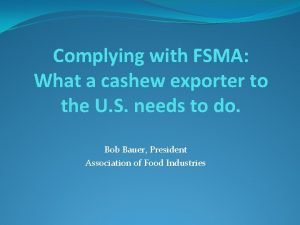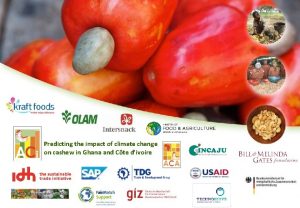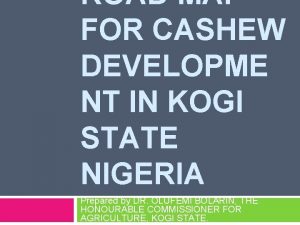LECTURE 4 CASHEW ANACARDIUM OCCIDENTALE L Cashew Anacardium

























- Slides: 25

LECTURE 4

CASHEW (ANACARDIUM OCCIDENTALE, L. )

Cashew (Anacardium occidentale, L. ) v ORIGIN AND DISTRIBUTION Ø Indigenous to South America. Introduced to North America, Asia, Africa and Australia by the Portuguese explorers th between 15 th and 16 centuries. Ø Commercially grown in many countries in 4 continents: Asia, Australia, South America and Africa. Ø Cashew was introduced as an erosion controlling-plant in the th Eastern part of Nigeria in the 16 centuries. Ø The potentials of cashew as a crop was recognized in the 20 th centuries. Ø Commercial cultivations started in Nigeria in 1950 s at Oghe, Oji, Udi and Mbala by the Old Eastern Nigeria Development Corporation (ENDC) and Iwo, Eruwa and Upper Ogun by the Old Western Nigeria Development Corporation (WNDC).

Cashew in Nigeria v Cashew is cultivated in all agro-ecological zones of Nigeria. Thus, it tolerates wide rainfall conditions of between 600 mm and 3, 000 mm per annum. v In Nigeria, commercial plantations of the crop are found in 27 states: Abia, Anambra, Enugu, Imo, Edo, Oyo, Kogi, Benue, Ondo, Ogun, Osun, Kwara, Lagos, Adamawa, Akwa Ibom, Borno, Cross River, Ebonyi, Ekiti, Kaduna, Gombe, Kebbi, Nassarawa, plateau, Taraba, Niger, Zamfara and Federal Capital Territory. v Nigeria produces over 636, 000 tonnes of cashew nuts from 320, 000 ha. v Cashew is currently being cultivated for its kernel, a repository of all classes of nutrients which is traded world-wide.

v. Cashew thrives under harsh environmental conditions that are unfavourable to other crops. v. It is cultivated at altitude of between 170 m and 1000 m above sea level, but does not tolerate frost v. It flourishes within rainfall ranges of 500 mm-4000 mm per annum and temperature of 270 C-400 C. v. It tolerates infertile soils. Ideal soil requirement is deep, friable, well-drained sandy loam without hard pans.

v. Cashew ranks 3 rd in the world production of edible nuts that are traded globally v. The major cashew markets include USA, The Netherlands, Germany, Japan, United kingdom, South East Asia and Australia. v. Price of cashew nut per ton depends on the nutsize: The bigger the nut-size the higher the price. v. Various nut sizes of cashew nuts include: Jumbosize, Extra large, medium, small and Madras nuts

Plate 1: Variations in Cashew nut sizes.

Table 1. The International (Commercial) Grading of Cashew Kernel. Grading/Classification Specifications White wholes: W 180 (Super large or jumbo) Between 266 and 295 per kg W 210 (Large) Between 395 and 465 per kg W 240 Between 485 and 530 per kg W 280 Between 575 and 620 per kg W 320 Between 660 and 706 per kg W 450 Between 880 and 990 per kg. White pieces: Butts Kernel broken cleanly across the section of the nut. Splits Kernel broken down the natural line of cleavage. Pieces Kernel broken into pieces smaller than splits. Small pieces As above but smaller Baby bits Very small pieces of kernel, white in colour. Scorched grades: Wholes Whole kernels slightly scorched during processing but otherwise sound.

Plate 2: Roasted Cashew kernel of W 180 grade.

Raising Cashew in the Nursery • Cashew seedlings are raised in the nursery through the nuts • Heavier nut-size are preferably used for seedlings production. • Seedlings produced by lighter nuts are less vigorous and hardly survive transplanting shock when eventually transplanted. • Cashew nuts become ripened between 9 th and 10 th week after pollination - colour of nuts changes from green to grey. • Freshly harvested nuts of cashew readily germinates when sown than stored nuts.

Raising Cashew in the Nursery Contd. • Cashew is not as exact in nursery requirement as coco / kola. • Polythene bag of 25 cm x 12 cm in dimension is suitable for the crop seedlings • Germination in cashew nuts falls within 2 nd and 4 th weeks after sowing in the nursery, provided it is given adequate watering after sowing. • Its nursery can be sited in an open environment because cashew is not a shade-loving crop. • If sited under a shade, immediately after germination, the tender seedlings assume phototropic growth response. This shows its zero shade tolerance.

Raising Cashew in the Nursery Contd. • Cashew seedlings are ready for transplanting into the field between 8 and 12 weeks nursery periods. • In a delayed transplanting, the seedlings become overgrown, its tap-root outgrows the rhizosphere into the soil, breaking of this root during transplanting operations results in transplant mortality. • Transplanting at a lesser nursery period, results in weakening of the seedlings, because their cotyledons are yet to wither. Breaking of these cotyledons causes loss of vigour in cashew seedlings.

Plate 3: Six-week old cashew seedlings. (Note the cotyledons and performance)

Transplanting of cashew seedlings into the field. • Cashew seedlings are transplanted into a clear-fell field after a period of 8 – 12 weeks in the nursery. • Only vigorous seedlings are transplanted. • No nurse plant nor shade trees needed in a cashew plantation. Moisture availability must be adequate. • The crop is transplanted at a spacing of 9 m x 9 m. Closer spacings of 6 m x 6 m, 4. 5 m x 4. 5 m are possible, but, the trees have to be later thinned to a wider plant spacing when the canopy becomes bigger.

Peculiar maintenance operations in cashew • Weeding: Wider planting spacing affords stiff competition by weeds especially broad leaf weeds. • Pruning: A continuous maintenance operation in cashew. Two adjacent cashew trees touching one another will cease to flower nor fruit. • Selective thinning: A densely planted cashew trees will be thinned at a shorter period than cashew trees planted at a recommended spacing. • Protection from rodents/marauders: Grass-cutters, bush-rats and lizards are destructive to cashew seedlings especially in the dry season. Protect seedlings with wire-netting or plastic paint containers opened at both ends. • Protection against fire outbreak.

Plate 4: An Interlocked (Unpruned) cashew plot.

Plate 5: Transplanted cashew seedlings protected with paint containers against marauders.

Insect Pest of Cashew v. Root and stem borer (Plocaederus ferrugineus): Ø The insect bores holes into the root and stem of cashew plant. Ø Tunnel from the root up to the upper part of stem. Ø Gum exudates form the base of cashew stem. Ø Yellowing of the plant’s leaves. Ø Eventual death of cashew plant v. Control measures: Ø Rub the base cashew trees with a mixture of coal tar and kerosene to prevent the infestation. Ø Uproot the infested cashew trees and burn outside the plantation.

Plate 5 a: A young cashew tree infested by root and stem borer (Plocaederus ferrugineus)

Plate 5 b: An old cashew tree infested by root and stem borer (Plocaederus ferrugineus)

Plate 6: A cashew tree killed by Plocaederus ferrugineus infestation.

v. Stem girdler (Analeptis trifasciata): ØThe insect chews round the stem (lateral and horizontal) in form of a girdling. ØThe affected branch becomes withered and dies. ØInfestation occurs during the fruiting period of cashew. v. Control measures: ØRemove and burn the infested branches. ØHand-pick and kill the insects. ØRemove spondia mombin in and around cashew plantations because it is an alternative host.

Plate 7: A young cashew plant girdled by Analeptis trifasciata.

Plate 8: Analeptis trifasciata infesting a branch of cashew (gnarled portion contains the insect’s eggs).

Harvesting • Cashew nuts are ready for harvesting between 9 and 10 weeks after pollination. • Harvesting in cashew is by picking the fallen nuts. v. Post harvest handling: § § Removal of foreign bodies. Sorting Sun-drying Bagging
 Ecole occidentale de meditation
Ecole occidentale de meditation La chiesa in occidente e il monachesimo
La chiesa in occidente e il monachesimo World cashew conference
World cashew conference Cashew processing training
Cashew processing training Mango cashew family
Mango cashew family Cashew nut
Cashew nut Raw cashew nut quality
Raw cashew nut quality Cashew stem girdler
Cashew stem girdler 01:640:244 lecture notes - lecture 15: plat, idah, farad
01:640:244 lecture notes - lecture 15: plat, idah, farad Lecture z
Lecture z Relecture automatique de formulaires
Relecture automatique de formulaires What is farsightedness called
What is farsightedness called Micropaleontology definition
Micropaleontology definition Jean baptiste perrin nobel prize lecture
Jean baptiste perrin nobel prize lecture Lecture about seasons
Lecture about seasons Natural language processing lecture notes
Natural language processing lecture notes Physics 101 lecture notes pdf
Physics 101 lecture notes pdf What does reverend cram want the iroquois to do?
What does reverend cram want the iroquois to do? La compréhension en lecture giasson résumé
La compréhension en lecture giasson résumé Tarsals lecture
Tarsals lecture Medsoderm
Medsoderm Shape memory alloys lecture notes
Shape memory alloys lecture notes Social psychology lecture
Social psychology lecture Android lecture
Android lecture Biophysics lecture
Biophysics lecture Lecture galerie api 20e
Lecture galerie api 20e




